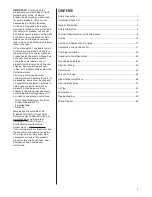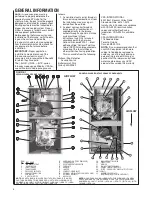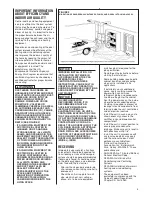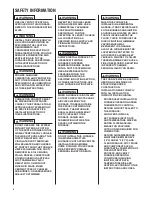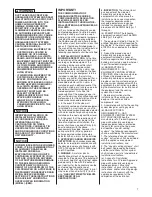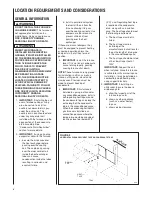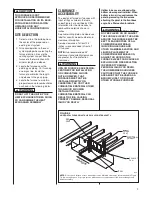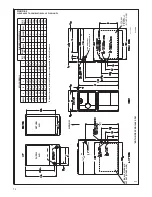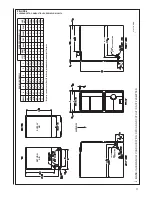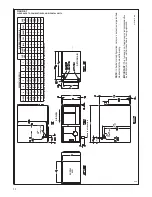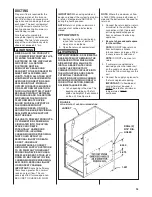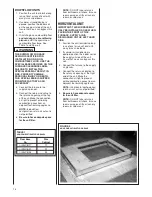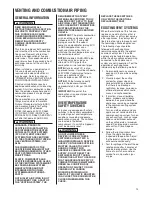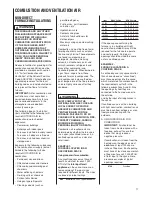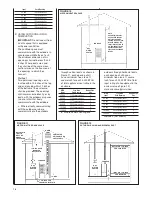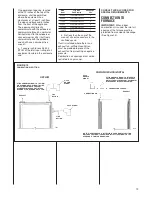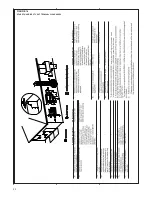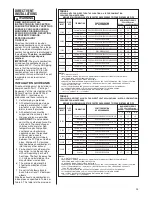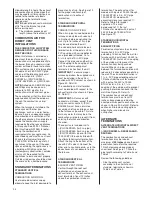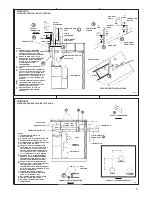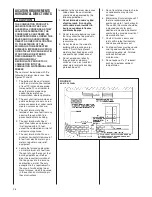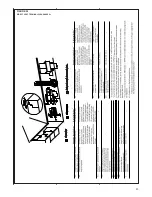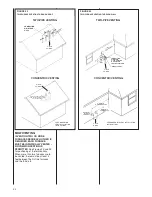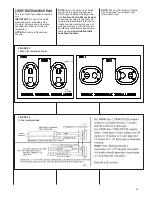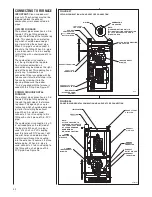
17
NON-DIRECT
FURNACE INSTALLATIONS
THE FURNACE AND ANY OTHER
FUEL-BURNING APPLIANCE MUST
BE PROVIDED WITH ENOUGH
FRESH AIR FOR PROPER
COMBUSTION AND VENTILATION
OF THE FLUE GASES. MOST
HOMES WILL REQUIRE THAT
OUTSIDE AIR BE SUPPLIED INTO
THE FURNACE AREA. FAILURE TO
DO SO CAN CAUSE PERSONAL
INJURY OR DEATH FROM
CARBON MONOXIDE POISONING.
Adequate facilities for providing air for
combustion and ventilation must be
provided in accordance with section
5.3, “Air for Combustion and
Ventilation” of the National Fuel Gas
Code, ANSI Z223.1 (latest edition) or
applicable provisions for the local
building codes, and not obstructed so
as to prevent the flow of air to the
furnace.
IMPORTANT:
Air for combustion and
ventilation must not come from a
corrosive atmosphere. Any failure
due to corrosive elements in the
atmosphere is excluded from
warranty coverage.
The following types of installation
(but not limited to the following) will
require OUTDOOR AIR for
combustion, due to chemical
exposures:
• Commercial buildings
• Buildings with indoor pools
• Furnaces installed in laundry rooms
• Furnaces in hobby or craft rooms
• Furnaces installed near chemical
storage areas.
Exposure to the following substances
in the combustion air supply (but not
limited to the following) will also
require OUTDOOR AIR for
combustion:
• Permanent wave solutions
• Chlorinated waxes and cleaners
• Chlorine-based swimming pool
chemicals
• Water softening chemicals
• De-icing salts or chemicals
• Carbon tetrachloride
• Halogen type refrigerants
• Cleaning solvents (such as
perchloroethylene)
• Printing inks, paint removers,
varnishes, etc.
• Hydrochloric acid
• Cements and glues
• Antistatic fabric softeners for
clothes dryers
• Masonry curing and acid washing
materials
Combustion air must be free of acid-
forming chemicals such as sulphur,
fluorine and chlorine. These elements
are found in aerosol sprays,
detergents, bleaches, cleaning
solvents, air fresheners, paint and
varnish removers, refrigerants and
many other commercial and
household products. When burned in
a gas flame, vapors from these
products form acid compounds. The
acid compounds increase the dew
point temperature of the flue products
and are highly corrosive after they
condense.
ALL FURNACE INSTALLATIONS
MUST COMPLY WITH THE
NATIONAL FUEL GAS CODE AND
LOCAL CODES TO PROVIDE
ADEQUATE COMBUSTION AND
VENTILATION AIR FOR THE
FURNACE. FAILURE TO DO SO
CAN RESULT IN EXPLOSION, FIRE,
PROPERTY DAMAGE, CARBON
MONOXIDE POISONING,
PERSONAL INJURY OR DEATH.
Combustion air requirements are
determined by whether the furnace is
in an open (unconfined) area or in a
confined space such as a closet or
small room.
EXAMPLE 1:
FURNACE LOCATED IN AN
UNCONFINED SPACE
Using indoor air for combustion.
An unconfined space must have at
least 50 cubic feet for each 1,000
BTUH of the
total input for all
appliances
in the space. Here are a
few examples of the room sizes
required for different inputs. The sizes
are based on 8-foot ceilings.
BTUH
Minimum Sq. Feet
Typical Room Size
Input
With 8' Ceiling
With 8' Ceiling
45,000
281
14' x 20' OR 16' x 18'
60,000
375
15' x 25' OR 19' x 20'
75,000
469
15' x 31' OR 20' x 24'
90,000
563
20’ x 28’ OR 24’ x 24’
105,000
657
20' x 33' OR 26' x 25'
120,000
750
25' x 30' OR 24' x 32'
If the open space containing the
furnace is in a building with tight
construction, outside air may still be
required for the furnace to operate
and vent properly. Outside air
openings should be sized the same
as for a confined space.
EXAMPLE 2:
FURNACE LOCATED IN A
CONFINED SPACE
A confined space (any space smaller
than shown above as “unconfined”)
must have openings into the space
which are located in accordance with
the requirements set forth in the
following subsections A and B. Size
the openings by how they are
connected to the heated area or to
the outside,
and by the input of all appliances in
the space.
If confined space is within a building
with tight construction, combustion air
must be taken from outdoors or area
freely communicating with the
outdoors.
A. USING INDOOR AIR FOR
COMBUSTION
IMPORTANT:
Air should not be
taken from a heated space with a
fireplace, exhaust fan or other
device that may produce a
negative pressure.
If combustion air is taken from the
heated area, the openings must
each
have at least 100 square
inches of free area. Each opening
must have at least one square inch
of free area for each 1,000 BTUH
of total input in the space. Here
are some examples of typical
openings required.
BTUH
Free Area
COMBUSTION AND VENTILATION AIR
!
WARNING
!
WARNING
Summary of Contents for RGRK SERIES
Page 41: ...41 FIGURE 39 TYPICAL MANIFOLD PRESSURE READING...
Page 45: ...45 FIGURE 43 UT Electronic Controls 1095 201 IFC TWINNING CONNECTION SINGLE STAGE OPERATION...
Page 60: ...60 FIGURE 53 TROUBLESHOOTING CHART or IFC not properly grounded Go To Next Page...
Page 61: ...61 FIGURE 53 TROUBLESHOOTING CHART CONTINUED...
Page 62: ...62 FIGURE 54 WIRING DIAGRAM...
Page 63: ...63...
Page 64: ...64 CM 0510...

